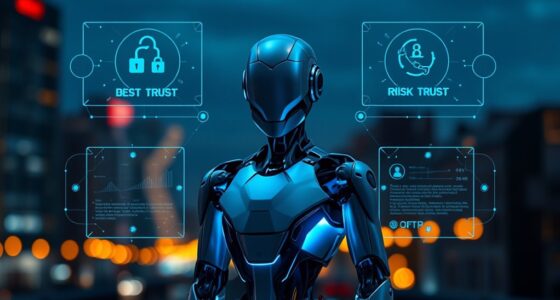AI’s revolutionizing cybersecurity by helping you protect your data in today’s digital landscape. It analyzes real-time data to spot patterns and detect threats instantly. With automated responses, it swiftly contains potential cyberattacks, reducing response times. While AI complements traditional measures, it also faces challenges, like being targeted by cybercriminals. Understanding its ethical use guarantees responsible deployment. There’s much more to discover about AI’s role in securing your digital world and how it adapts to threats.
Key Takeaways
- AI analyzes large data volumes to detect patterns and anomalies that signal potential cybersecurity threats in real-time.
- Automated responses enable AI systems to swiftly contain cyberattacks without human intervention, enhancing digital security management.
- AI complements traditional cybersecurity methods, addressing sophisticated threats while emphasizing multi-layered security approaches.
- Despite its advantages, AI faces challenges, including adversarial use by cybercriminals and the need for continuous updates and human oversight.
- Ethical deployment of AI in cybersecurity fosters transparency, accountability, and trust, addressing concerns about misuse and bias in decision-making processes.

How well can AI protect your digital assets? In today’s rapidly evolving digital landscape, the stakes are high, and the threats are more sophisticated than ever. You’ve likely heard about the rise of cyber threats, from ransomware attacks to data breaches. With so much at risk, you might wonder how AI can step in to safeguard your valuable information. The truth is, AI has become a game changer in cybersecurity, offering tools and techniques that enhance your defenses like never before.
AI systems analyze vast amounts of data in real-time, spotting patterns and anomalies that human eyes might miss. This means you can detect suspicious activities almost instantly. Imagine a system that learns from your typical online behaviors and can alert you when something out of the ordinary happens. It’s like having a digital watchdog that never sleeps, always on the lookout for threats. You can respond to potential breaches much faster than relying solely on human monitoring.
AI systems act as vigilant digital watchdogs, detecting suspicious activities in real-time and enhancing your security response.
Moreover, AI-driven solutions can automate responses to certain types of threats. When a potential cyberattack is identified, these systems can initiate containment measures without waiting for human intervention. This rapid response is essential because, in cybersecurity, time is often of the essence. By leveraging AI, you’re not just reacting to threats; you’re proactively managing your digital security. Additionally, the rise of pimple patches has shown how targeted treatments can effectively address specific concerns, much like how AI tackles particular cybersecurity threats.
However, while AI is powerful, it’s not infallible. Cybercriminals are also using AI to create more sophisticated attacks, such as deepfakes or automated phishing campaigns. That’s why it’s fundamental to combine AI tools with traditional cybersecurity measures. You can’t rely solely on technology; you need to stay informed and educated about the latest threats and best practices. By adopting a multi-layered security approach, you can bolster your defenses even further.
Additionally, the ethical considerations surrounding AI in cybersecurity shouldn’t be overlooked. As these technologies evolve, ensuring that they’re used responsibly and transparently is essential. You want to trust the systems that protect your data, and that trust is built on accountability and ethical use.
Frequently Asked Questions
How Does AI Differentiate Between Legitimate and Malicious Activity?
AI differentiates between legitimate and malicious activity by analyzing patterns in data. It learns from historical data, identifying normal behavior and flagging anomalies. You’ll find that machine learning algorithms continuously adapt, improving their accuracy over time. By monitoring user behavior, network traffic, and system logs, AI can detect irregularities that suggest threats. It combines statistical analysis with predefined rules to make real-time decisions, helping to protect against potential cyber attacks effectively.
Can AI Predict Future Cyber Threats Effectively?
Yes, AI can effectively predict future cyber threats by analyzing patterns and trends in historical data. It identifies anomalies and potential vulnerabilities, allowing you to stay one step ahead of attackers. By continuously learning from new data, AI adapts to evolving tactics used by cybercriminals. You’ll find that its predictive capabilities enhance your overall security posture, enabling you to implement proactive measures before threats materialize, ultimately safeguarding your valuable information and systems.
What Are the Limitations of AI in Cybersecurity?
AI in cybersecurity has its limits, like a bird in a cage, unable to soar beyond its programming. It struggles with interpreting context and nuance, often missing out on subtle threats that a human might catch. Its reliance on historical data means it can’t predict entirely new attack patterns. Plus, if the data’s biased, it risks making flawed decisions, leaving you vulnerable. So, while powerful, it’s not a foolproof guardian.
How Does AI Handle False Positives in Threat Detection?
AI handles false positives in threat detection by continuously learning from previous data and user feedback. When it identifies a potential threat, it assesses context and patterns to determine the likelihood of a true positive. If a false positive is flagged, the system adjusts its algorithms accordingly to improve accuracy. This adaptive learning helps reduce unnecessary alerts, allowing you to focus on genuine threats and enhancing overall security efficiency.
Is AI in Cybersecurity Cost-Effective for Small Businesses?
Yes, AI in cybersecurity can be cost-effective for small businesses. It automates threat detection and response, reducing the need for extensive human resources. With AI, you can identify vulnerabilities and respond to incidents more quickly, minimizing potential losses. Additionally, many AI solutions are scalable, meaning you can tailor them to your budget and needs. Investing in AI might save you money in the long run by preventing costly data breaches and enhancing your security posture.
Conclusion
In an ever-evolving digital landscape, AI stands as a powerful ally in the fight against cyber threats. By harnessing its capabilities, you can bolster your defenses and protect your sensitive data more effectively. But with the rise of AI, can you afford to overlook its potential in your cybersecurity strategy? Embracing these advanced technologies not only enhances your security posture but also guarantees your organization stays one step ahead of cybercriminals in this digital world.









